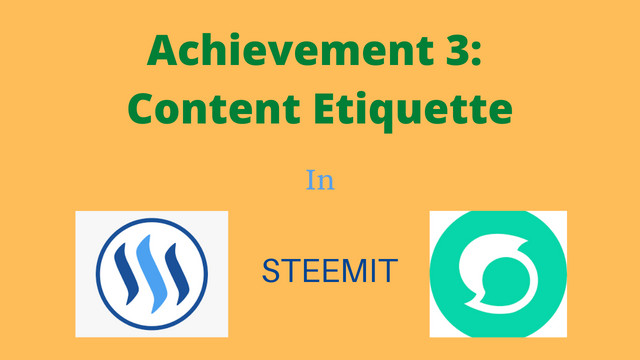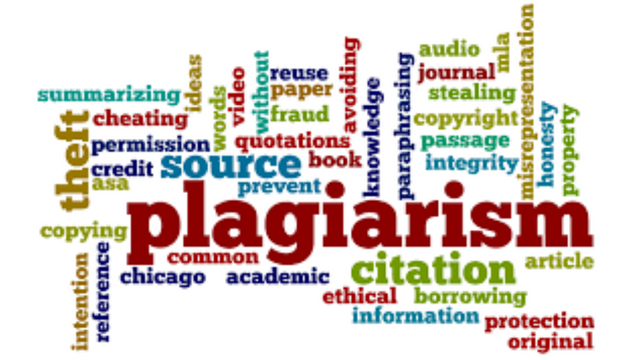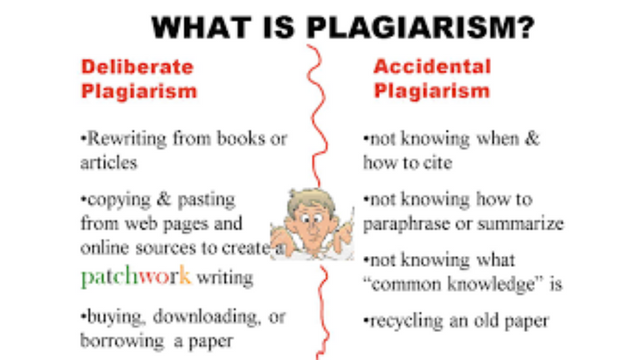.png)
What is Plagiarism
Plagiarism means using someone else’s work without giving them proper credit. In academic writing, plagiarizing involves using words, ideas, or information from a source without citing it correctly. Source
“Plagiarism can occur in many different contexts. While often associated with school assignments, it can also happen in professional settings, such as the arts, academia, and the business world.” Source

Source: SavannahState
Many times we may not be aware of the term Plagiarism and the implications it has on our works. The first time I came across the word plagiarism was back in the university when I was doing project work in my final year. I thought it was a fancy word that is used to describe copying and pasting some article found on the internet, but I later realized it is much deeper than that.
Just like me, when people hear about plagiarism, the first thing that comes to mind is simply copying another person's work or ideas. This is where the problem lies because the term "copying" makes plagiarism look like something without a serious consequence. But it really does have serious consequences depending on how the work of another person has been plagiarized.
An example of how dire the consequences of plagiarism can be found in the resignations and the revoking of the degrees of prominent politicians such as former Senator John Walsh, former German Defence Secretary Karl Theodor zu Guttenberg, and former Hungarian President Pal Schmitt. Source: CNN
The common way plagiarism is committed is through text or written words, however, plagiarism can be committed through other ways using things like images, data, music, and art. With this in mind, any time work is created by someone else and is used in your own work whether, in part or full, credit must be given to that person.
The main reason why the act of plagiarism is taken very seriously is that the works that have been plagiarised are the ideas of the original author, and these ideas are regarded as intellectual property and are thus protected by copyright laws. The ideas when brought out are a form of expression, and as long as they have been recorded in any way, they fall under copyright protection.
There are various ways by which plagiarism can be avoided, but a good place to start is by simply citing the source of the work of the original author. By doing so, you acknowledge the fact that the material used in your work was borrowed and also let those looking at your work know the original source of the material.
Forms of Plagiarism

Source: LCPS
Plagiarism is something that is diverse as it touches so many aspects of our daily lives. That said, plagiarism comes in different forms. Some of them include:
Making use of different parts of the works of others by copying and pasting without properly citing them.
Blattanly submitting the full works of others by rewriting from their books or articles and then putting your name on it.
Paraphrasing the words of another person so that it would look like it was originally made by you.
Another astonishing form of plagiarism is using all or parts of a former work previously done by you. This is known as Self-plagiarism.
Not having an idea of how to cite which also leads to not knowing when to cite.
Not having an idea on how to paraphrase or summarize sentences and articles.
All these forms of plagiarism lead to categorizing them into Deliberate and Accidental Plagiarism.
As we can see deliberate plagiarism is an act of plagiarism that is committed consciously and on purpose. While accidental plagiarism is one that is committed due to ignorance of certain things like summarization.
Effects of Plagiarism
Plagiarism can lead to something as simple as failing a subject in school or to something as complex as getting into a serious legal battle, depending on how the plagiarism was committed.
Failing a subject in school is mostly related to school students of any level ranging from bachelor degree holders to those working to become a professor. Although failing a subject or merely an assignment could be seen as okay, it usually strikes a message at the back of the person who commits the act of plagiarism and those around them.
Then getting into serious legal battle is related to those who are trying to publish their professional work. It could be writing a book, singing a song, or even an academic dissertation. This is because the works of others are considered intellectual property, especially when it has been copyrighted. Once violated can lead to serious legal consequences.
What Make Plagiarism Bad?
By committing the act of plagiarism, it leads to the theft of intellectual property. Furthermore, it makes it such that the owner of the work that has been plagiarised did not give credit to the original author.
For those in the world of academics, plagiarism means that the perpetrator was dishonest in his work. It is expected that you make use of your knowledge base to perform any exercise or research given. Through this, you can directly have an impact on your audience with your original work.
But when you make use of other people's work without citing them, it misleads your audience and therefore has a negative impact on them.
It is very important to distinguish your own words and ideas and that of someone else in your work by citing them if you decide to take some ideas from someone else's work. This gives your work a better standard as you have given reference to where some of your ideas came from. It also allows your audience to get more info from the original source of the borrowed ideas.
Then those in the world of art and creative industry, that is, people who make music, visual art, etc see plagiarism as theft. When you publish something that you didn't create, then go on to sell it deprives the original author of money that should be his own and also the recognition for their work.
Ways to Prevent Plagiarism
There are various ways to prevent plagiarism, but the starting point is by making sure to cite the sources where some ideas have been borrowed. Another way to prevent plagiarism is to quote a written text using quotation marks and citing the sources of them. You can also paraphrase them and use the > sign along with it. It shows that the written word was derived from somewhere else, then you cite it also.
This way you give your audience the benefits of being impacted positively and letting them know where the source is. It also gives due credit to the originator of the written text which is plausible. Finally, it adds a bit of professionalism to your write-up.
Ps: I have read and understood the Steemit Etiquette on Steemit Community and will do my best to embrace them.
Here is my Introductory Post
@goodybest
@ngoenyi
@whitestallion
@focusnow
@cryptokanno
@bright-obias
@Pricelesspresh
Congratulations !
You have successfully completed achievment 3 task on "Steemit Content Etiquette". You can now proceed to Achivement 4 : Applying Markdown styles
Curation Rate - 3
Keep following @steemitblog for the latest updates and news on steemit platfrom and follow @steemingcurators to find more information about new contests and events.
Downvoting a post can decrease pending rewards and make it less visible. Common reasons:
Submit
@bright-obias Thank you for verifying my post I just completed achievement 4task kindly check.
Thank you
Downvoting a post can decrease pending rewards and make it less visible. Common reasons:
Submit
Hi, @cherish22,
Your post has been supported by @bright-obias from the Steem Greeter Team.
Downvoting a post can decrease pending rewards and make it less visible. Common reasons:
Submit
Thank you for your surport...... We all grow together
Downvoting a post can decrease pending rewards and make it less visible. Common reasons:
Submit